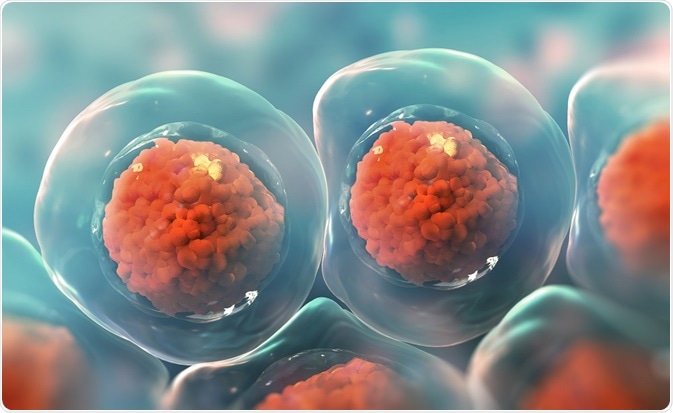Oligosaccharides are constructed from carbohydrate monomer units which contain multiple hydroxyl groups, along with amino and carboxyl groups. Protecting groups play a vital role in oligosaccharide synthesis as they help in differentiating not only the same type of functional groups but also the different functional groups present in the carbohydrate.
 Image Credit: Yurchanka Siarhei / Shutterstock
Image Credit: Yurchanka Siarhei / Shutterstock
Oligosaccharides are one of the most important class of biomolecules, playing a critical role in important biological processes like cell adhesion, immune response, bacterial and viral infection and cell differentiation and proliferation.
However, due to their low abundance in nature, it is difficult to get pure, structurally well-defined and reasonable quantities of oligosaccharides. The chemical synthesis of oligosaccharides has been instrumental in solving this problem for evaluating critical biological processes.
Desired characteristics of protecting groups
The synthesis of oligosaccharides is a challenge. This is due to the versatility of glycosylation (either alpha or beta linkages) and the presence of a large number of functional groups which necessitate the use of specific protecting groups to obtain the desired chemoselectivity and regioselectivity.
Protecting groups are used to temporarily mask a functional group that cannot survive the chemical environment. However, they can participate directly or indirectly in the glycosylation reactions altering the stereochemical outcome. Hence, an ideal protecting group should have the following characteristics:
- Readily available
- It should not introduce the formation of new stereogenic centers
- Stable in order to withstand the synthesis process
- Creates a product that is more lipophilic and crystalline
- The by-products produced should not alter other parts of the molecule and be able to be easily removed
Types of protecting groups
Participating groups
2-O-acyl group:
Classical neighboring group participation involves the participation of the acyl group at C2 position. In the glycosylation reaction, the acyl group of the donor aids in the removal of an activated leaving group leading to the formation of the stable dioxolenium ion. Therefore, the glycosyl acceptor can attack only from one side to form the 1,2-trans glycoside.
Many ester-type groups such as acetate, chloroacetate, benzoate and pivaloate have been used to make 1,2-trans glycosidic linkages. Occasionally, formation of orthoesters and harsh removal conditions prevent the formation of 1,2-trans glycosides.
Improved ester groups like 4-acetoxy-2,2-dimethylbutanoyl (ADMB) overcome these drawbacks and enable stereoselective synthesis of b-glucopyranosides.
The deprotection conditions are mild involving hydrogenolysis through intramolecular lactonization. 3-(2-Hydroxyphenyl)-3,3-dimethylpropanoate (DMBPP) and 3-(2-hydroxy-4,6-dimethylphenyl)-3,3-dimethylpropanoate groups (TMBPP), when placed at the C2 position enable synthesis of b-glucopyranosides and a-mannopyranosides in good yield. These groups are removed by hydrogenolysis in the absence of acid or base.
Dialkyl phosphates:
The glycosylation of a thioglycoside having a 2,2-dimethyltrimethylene (DMTM) phosphate group at the C2 position leads to the formation of 1,2-trans glycoside. The DMTM group is removed by sodium hydroxide in an ethanol-water solvent mixture.
Chiral auxiliary group:
A chiral auxiliary group is a substituted ethyl moiety that contains a nucleophilic group positioned at C2 of the glycosyl donor. Upon formation of a oxocarbenium ion, the participation of the nucleophilic moiety controls the stereochemical outcome of glycosylation by forming cis- or trans- decalin system depending on the configuration of the chiral auxiliary.
If the chiral auxiliary has a S-configuration, it favors the formation of 1,2-cis glycoside via a trans-decalin intermediate. If the auxiliary at C2 position of the glycosyl donor has a R-configuration, it gives 1,2-trans glycoside via a cis-decalin intermediate.
Conformation-constraining protection groups
Conformation-constraining protecting groups restrict the flexibility of the sugar ring aiding a certain conformation of the intermediate thereby making the glycosyl intermediate easily accessible from one side.
Cyclic bifunctional groups such as benzylidine, carbonyl (carbonate, oxazolidinone) and cyclic silyl groups are some examples of conformation-constraining protecting groups. The benzylidine group is used to construct a b-mannosidic linkage by the formation of an a-triflate intermediate.
Similar to the 4,6-O-benzylidene-directed mannosylation, carbonates also use the same mechanism for the synthesis of b-glucosides. The oxazolidinone group is very useful in the synthesis of a-2-amino-2-deoxyglucopyranosides and a-sialosides.
4-nitrophenyl chloroformate is used to introduce an oxazolidinone group as a non-participating group at C2 and enables the simultaneous differentiation of the 2-amino and 3-hydroxyl group from other hydroxyl groups. 5-N,4-O-carbonyl-protected sialyl donor showed high reactivity and high a-selectivity in sialylation reactions.
The glycosylation reaction with a donor having the cyclic silyl group di-tert-butylsilylene (DTBS) gives predominantly a-selective products. 3,5-O-Di-tert-butylsilylene group was introduced in an arabinosyl donor to construct b-selective arabinofuranosides which are important constituents of microbial and plant polysaccharides. A donor with 3,4-O-bisacetal protecting group was used for b-selective glucosylation.
Sources:
- Polyakova SM, Nizovtsev AV, Kunetskiy RA and Bovin NV “New protecting groups in the synthesis of oligosaccharides” Russ.Chem.Bull., Int.Ed., Vol 64, No. 5, May, 2015.
- Guo J and Ye Xin-Shan “Protecting groups in carbohydrate chemistry: Influence on stereoselectivity of glycosylations” Molecules, 2010, 15, 7235-7265.
Further Reading